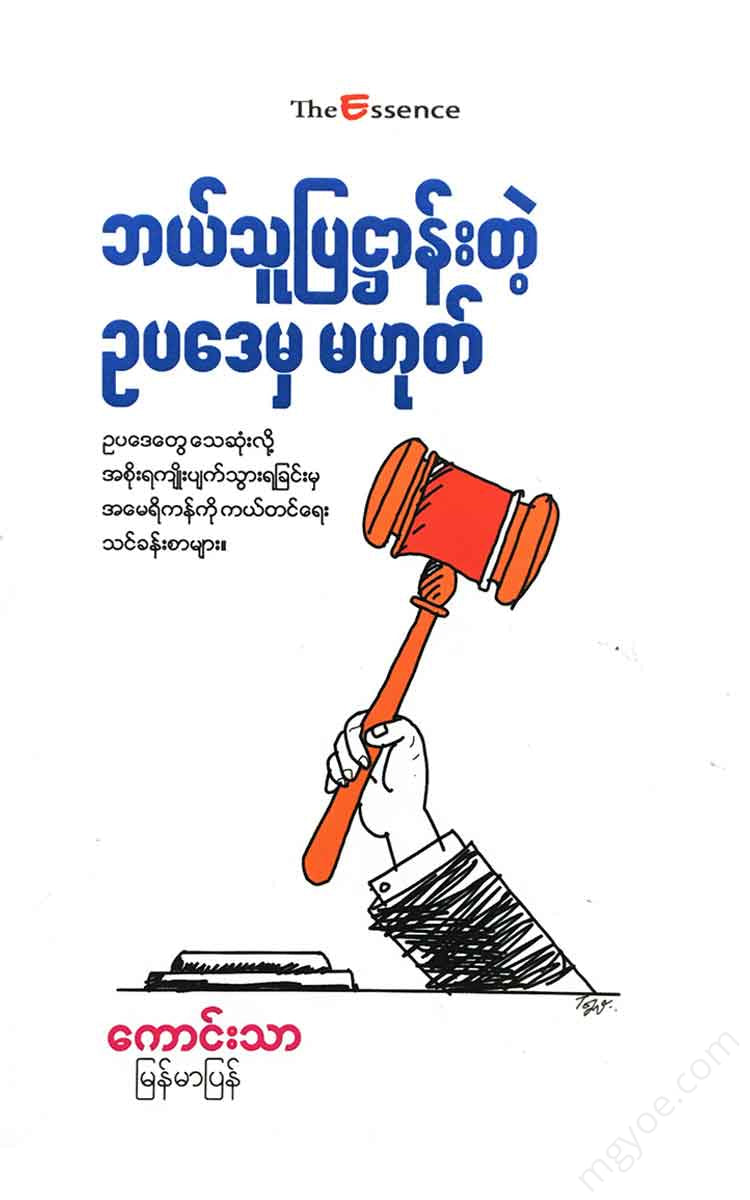စိတ်ကူးချိုချိုစာပေ
Good - not a law that anyone has made
Good - not a law that anyone has made
Couldn't load pickup availability
( 1 )
No one's law.
The Bayou Bridge connects New York Harbor to the East Coast's largest port, New York Harbor. It opened in 1931 and is the fourth-largest single-arch bridge in the world. Architectural historians consider it a masterpiece. The four-lane roadway inside the arch is 151 feet above sea level. That height is a challenge. The latest generation of container ships are taking advantage of the wider Panama Canal, which allows them to pass through without any problems. The canal is 215 feet above sea level, allowing these large ships to pass through without any problems. The Newport Bridge is still used by smaller ships.
A government agency took on the task of solving this problem. The Port Authority of New York and New Jersey sent its engineers to the site. In 2008, they came up with two solutions. Build a brand new bridge or dig a canal. Both of these would require roads. Locals would object. Each could cost $4 billion. Once completed, the iconic Bayou Bridge would have to be demolished.
The person responsible for formulating the solutions is project manager Joanne Pa-George, a 28-year-old former Port Authority employee. “It’s not always practical to push for a new bridge,” she says, asking engineers if they could retrofit the classic bridge. The idea is clearly complex. It’s a classic, with a construction reputation that’s more than 80 years old.
A few months later, engineers submitted a report. The only way to rebuild the roadway inside the Grand Canal was to raise it to its original height. No new foundations, no new access roads. The remaining part of the roadway could be raised while the rest remained open. The total cost would be $1 billion. A saving of $3 billion. This solution seemed like a miracle to the minds of those days. )
This was an idea that came to mind in 2009. At the beginning of 2013, the port authorities had still not approved the start of construction. So... who is responsible?
In the United States, building something important requires multiple layers of approvals, going through multiple levels of government. This project required 47 permits from 19 government agencies. When it comes to environmental reviews, academic exercises are like the most complicated game. Multiple agencies are involved. “The process is not focused on solving the problem,” says Mitt.
George noted, "If you try to find a solution to a problem, you'll just get a 'no'." Something is wrong.
The bridge's current goal is to allow larger ships to pass through, which is important not only for the local economy but also for the environment. The latest generation of ships are cleaner and can load cargo more efficiently. It's important to do it in time. The expanded Panama Canal is set to open in 2015.
But the decision has to be made by someone. The process is messy. Environmental protection laws allow for a brief oversight by the lead agency.
At the end of the process, the lead agency can either make a “no-nonsense solution” (known as a FONSI) or a full conservation declaration .
In principle, a brief environmental review is being prepared, with public comments being sought for 45 days.
The lead agency that would have to make a decision after collecting the data was no longer their job, and no official was willing to do anything about it. Mr. George sent a letter of request to the Coast Guard Corps of Engineers. Ultimately, the Coast Guard was left to decide. It took almost a year to find a lead agency.
There will be more studies to be done. For example, the Port Authority is required to oversee a historical site survey of every building within a two-mile radius of the bridge. No environmental official has claimed to have the authority to fulfill this requirement. They do not touch any building project. The procurement process is a bureaucratic drama involving hiring an expert. The expert cost $200,000 from start to finish.
As federal and state laws have become more and more complex, Native American tribes have had the opportunity to join the environmental conservation committee. The tribes that have joined include the “Sioux Indians of Oklahoma and the Sandhill Indians of Nevada. A group of tribes based in New Jersey have decided to join the review process.”
A group called the “Eastern Environmental Law Center” has begun to reject this project. More capacity
Good ships can already successfully navigate the Newport Port, so if the project goes ahead, more trucks will be parked and traffic congestion will increase. This logic
As a result, the Port Authority decided that the project should be suspended, leaving the port's capacity at its current low level.
The EPA local office embraced this idea and sent a letter to the Coast Guard in mid-2012. It determined that the Newport Harbor project was not necessary because it had been studied to determine whether it was in the public interest to continue the project in an environmentally sound manner.
On July 19, 2012, President Obama designated the Bayou Bridge as one of the nation's seven most important high-rise projects, and decided to support its completion. He set a deadline of April 2013 for the review decisions to be finalized.
Who gives the president the authority to decide the right balance between jobs and environmental concerns? Local activists are threatening to sue to stop this project.
On May 23, 2013, three years after the project began, the Coast Guard announced that it found nothing unusual about the project and did not consider it for consideration. Now, “Mister George” is facing a legal challenge. A project to replace the “Gothic” bridge, a mile to the south, has been waiting 10 years for approval.
The problem is that the government has done these things so badly. These failures in implementation are policy failures. For example, the rebuilding of America's infrastructure is a bipartisan priority. America's electrical equipment is outdated. Transformers are 40 years old, and the wiring is
It's old and the transfer stations are consuming about 7% of their power.
But there are no active plans to rebuild America's electric utilities. The main reason is that the government cannot make the decisions to approve them. Some people reject it because the lines that will have to pass through forests and deserts. If you multiply that by the bureaucratic hurdles that the Bayou Bridge has to go through, it could be a hundred times as much.
The government's inability to make fundamental choices is a national catastrophe. This book will provide a series of explanatory theories. We will see that our approach to government needs to shift.
Explanatory concept (1).
America has lost the ability to make public choices.
America produced the philosopher Hannah Arendt. She invented the idea of "no one is ruled by anyone, no one is ruled by anyone's laws." She spoke of the state of a bureaucrat who, unable to make meaningful choices in response to current needs, takes on a life of his own. A government that is out of control is increasingly disconnected from the society it serves.
The Bayon Bridge project could be summarized as follows: If someone had the power to draw a line,
"Oh, there's no need to go to the historical buildings." No one has the right to say that.
The modern government has designed a kind of legal machine. It is badly designed. In fact, it is one of the worst machines ever invented. Its fundamental flaw is that it encourages people to make choices without the judgment of the person at the moment of action.
Decisions are made through a legal process. Public servants are forced to follow a set of rules and procedures.
Think of government as a giant machine with gears, pedals, and a bunch of other things. It grew bigger by making laws, creating new procedures, and creating new programs. But modern government didn't just happen overnight, it was driven by the practicalities of those in charge.
"John Papa George" and the Bayonetta Bridge have achieved their goals with Herculean efforts. But they are not responsible leaders. The government goes as the machine goes. The law slowly crawls forward on autopilot.
We believe that government decisions should be consistent with what we know as the “rule of law.” This principle of fairness is universally accepted as the foundation of a free society.
"Frederick Hayet" wrote this.
“The government should be bound by the laws declared in all its actions, and should be established beforehand, with reasonable certainty as to how the authorities may exercise their sovereign powers in the circumstances given.”
This approach to public decision must be treated with respect from a theological perspective. “All laws should be clear and unambiguous,” Voltaire advised. “The only thing that can be done is to collect them.”
Political leaders have devoted their lives to blaming others for the government's failures. Here, they are all in agreement.
If you face a problem in today's society, ask yourself: Who is the authority that can solve this? The answer is no one.
Automatic laws restrict people
A detailed memorization system is causing more failures than it is improving government performance. New Jersey officials spent 12 days trying to pull a tree from a flooded stream.
Budgets are out of control because government officials lack the flexibility and precision to cut corners. New York Governor Andrew Cuomo, who was just elected, has been accused of defrauding a center that was used to house homeless teenagers, costing him $50 million in lost revenue. The center will probably never be used again. Dozens of employees are unemployed and millions of dollars in tax dollars are owed. But no one has the authority to close the center. Not even the governor can close it. No department with unionized employees can close it without at least a year of pay.
There is a York law. So the total tax revenue has to be $50 million. Giving $5,000 to each family out of ten thousand is a waste of public money.
In 1966, after the health care law was enacted, the architects of the senior health care program took a hard look at how they were doing business. Doctors and hospitals under the program changed their practice guidelines to maximize revenue. They relied on a fee-for-service model.
It's being built. Despite the testing programs, doctors and hospitals are charging patients huge fees. The architects of the legislation immediately became big budget-eating beasts.
Officials are taking advantage of the public funds flowing through the pipeline to overspend. The health care industry is struggling in a bureaucratic mess among government sponsors. Experts are finding that the need to abandon the idea of charging for services and instead create incentives for doctors, patients, and the public is growing. But there is no legal framework to do so.
After 50 years, Medicare and its companion Medicaid program have become the largest health care program in the world, consuming nearly 20% of the entire federal budget. Dr. Don Barbour, the Obama administration’s health care chief, estimates that Medicare wastes $200 billion a year. That’s because it’s rigged with fee-for-service incentives. Congress has the power to change the law. But politics is making that impossible.
In 2010, the three major health programs (Medicare, Medicaid, and Social Security) accounted for 70% of federal tax revenue.
Public servants are not allowed to be promoted for good performance, which is illegal. Employment is full of written and oral examinations.









